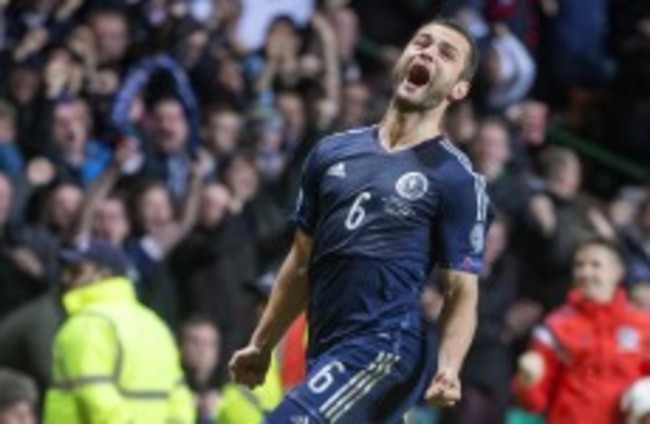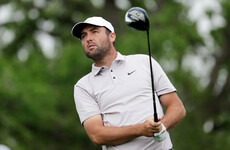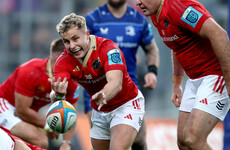IN THE AFTERMATH of last night’s 1-0 win over the Republic of Ireland, Scottish goalscorer Shaun Maloney spoke of how the team had worked on short-corner routines in the build-up to the game.
But, he admitted it was a variation on what they had been practicing and that the involvement of a third player in the move was done on the fly.
Here, we break down the goal and see what went wrong from an Irish perspective.
Setup
A short-corner is worked between two players. The taker passes to a team-mate and loops on the outside for two reasons. Firstly he can offer a dummy run, possibly allowing the team-mate more time/space to whip in a cross or take on an opponent along the touchline. Secondly and more commonly, the taker picks up a return pass and uses the angle to push past an opponent and either deliver a cross or take a shot on goal. The second pass is key – if it’s played across the receiver’s body, he doesn’t have to check his run and can take the pass at pace.
Shaun Maloney had previous before last night. As the 2011/2012 Premier League title race seemed done and dusted, he popped up with a superb winner against Manchester United at the DW Stadium that offered Manchester City a late lifeline.
As you can see below, it’s United’s lack of reaction that’s costly. Only one player has the quickness of mind to race out and close down the short-corner while, as mentioned above, the return pass to Maloney is perfectly-timed and allows him to push past Rooney’s half-tackle at pace before bending the shot to the far corner.
So, let’s look at last night.
Firstly, the Irish react well to the fact that Scotland have sent two players towards the corner flag. Jeff Hendrick and Stephen Quinn get out to Maloney and Anya and know what to expect. But immediately there’s a problem.
Just before Maloney plays his pass, Anya spots an unmarked Scott Brown and gestures at him to move into the area. It’s not planned because Maloney has to check the pass and wait until Anya is paying attention to him. Maloney has also spotted Brown but no one from the Irish team has.
Reaction
To give Quinn and Hendrick credit, they nullify the initial short corner threat. They keep good positions and because they’re on top of the duo quickly, it means Anya has to play a tight pass into Maloney’s feet and the Scots lose the chance to push towards the area immediately. Quinn ties Anya up and Hendrick is in a decent spot to shut down Maloney. Here, it looks like Ireland have done well and Scotland will have to be patient and probably go backwards to re-align themselves and look for space elsewhere.
But, the problem for Ireland is that no one has taken responsibility for Scott Brown. As soon as the short corner is played, there’s no need to keep a player on the post. Robbie Brady needs to move and have the awareness to shut down space in front of him. It’s incredible to think that he never reacts to Brown until it’s far too late – the amount of space Brown is in is inexplicable.
But, Hendrick sells himself too. By not committing and standing off Maloney, he places more pressure on the Scot because he then needs to think more about his next move and be more patient. By jumping in and trying to steal the ball in a dangerous position, Hendrick is gambling and leaving himself vulnerable. Yes, Maloney’s nutmeg is excellent but he could just as easily shifted the ball across his body onto his left foot and knocked it inside to Brown when Hendrick dives in. As Liam Brady pointed out last night, the Derby man had discipline problems and may have got lost in the atmosphere and intensity of the occasion. Maloney acts instinctively and suddenly the entire move has changed.
Communication
In the image below, you can see the problems a third man presents to a team defending a short-corner. Hypothetically, if Maloney is successful with an instant pass to Brown here, the midfielder can turn and shoot/cross himself or Anya can utilise the set-piece (Irish players on the goal-line so no offside, etc) to race along the by-line and pick up a Brown pass. But look at the Irish players. Brady is checking out Ireland’s attacking options should they have a chance to counter. He should be racing to get out to the unmarked Scottish captain ten yards away.
But also, his team-mates should be screaming at him to get out of the six-yard area and get out to Brown. Instead, there’s no reaction. Some Irish players can argue that they were too wrapped up in their own marking situations to direct Brady but David Forde doesn’t have the same excuse. As a goalkeeper, he needs to be more assertive here. Brady’s wandered away from the near post but what’s he doing? What’s his role? Forde needs to let him know. Someone needs to take ownership of the Irish defence in this situation and no one does.
Brown’s back-heel is perfect and enables Maloney to race onto the ball and curl it first-time. With Irish players stepping out to get in front of the shot, he inadvertently uses Jonathan Walters as a shield and Forde is left with little chance.















What a hammering! Brilliant stuff!
Tipp by 8 some lad commented earlier.Must be some comeback were in for!!
well done Galway
What went wrong today ?
Can’t blame the ref for that Tipp?
@Peter R: I think you’ll find it was Davy blaming the ref last week not Tipp.
@jane: would ya stop
He took his beating
And nOw Tipp may also.
In fairness
Michael Ryan is one of the best managers out there.
Very likeable
@Peter R: well if that’s Davy taking his beating I wouldn’t like to see him when he’s not.
@jane:
Look
Regarding this game
Maybe Tipp were admiring themselves too much from last weeks game and didn’t give Galway the respect they deserve.
It was men against boys today
@Peter R: looked to me that they didn’t even try today, some of the touches and fumbles were so bad and not even trying to win back lost ball. 4 Tipp management team never moved from the same spot the whole game.
@jane: maybe
But it is only league
Bigger challenges ahead.
Galway wanted it more.
Tipp will be in the final come September
On an aside. A week between semis and final. Bit unfair. Was it not always the 1st Sunday in may??
HT Galway the better team so far,They have alot of wides which could be very costly come the long whistle.
Galway Galway Galwat the great enigma!!!!
Galway should be out of sight. Setting themselves up for a usual second half collapse.
@Kevin Shortall: you might have spoke too soon on that one
@Kevin Shortall: cheers for the insight Kev, maybe you should give Brian Cody a call and tell him your ready to takeover … ;-)
Well done to Galway, some hammering to give Tipp,they will hardly be as bad again expect them now to give Cork a hammering in the first rd,swings and roundabouts.
Congratulations to Tipp on winning the league final.
@Niall Lonergan: deferred coverage???
Tipperary by 8
@lolly ryan: good lad
Ive said it before and ill say it again steven o brien cant hurl
@DerryWanderer14: good lad….us tipp lads must get you down to give us a few sessions so. Those lads picking tipp u16, minor, u21 and senior teams know nothing sure!! Even though you’ve said it before and though you’ll say it again more than likely from that bar stool you’re hurling on!
@mmk: i never said i could hurl i just said steven o brien cant, easily one of the best midfielders in the country with the big ball but his talent is been wasted in with the hurlers
@DerryWanderer14: but he obviously can hurl to a very high level….he has been consistently selected by various mgt for tip teams. Your statement is total crap! Granted he is a fantastic footballer but there’s also many other hurlers on the tipp team who didn’t have a good game today that are fine footballers too but you’re not making that statement about them? O’Briens contributions in the league has been very good v clare, wford, kk, offaly.
Cud the gaa not go to expense of resodding the goalmouths for a league final.So unsightly but only an oul league so who gives a f**k right lads?!
Barely 17k at the Hurling League Final, @gaa need to cop themselves on with ticket prices if it’s outside Dublin…
25€ for Students/OAP’s, same as Adult ticket…?
#GWYvTIP